 Nazi Germany (1929-43) – 4 Battleships: Scharnhorst, Gneisenau, Bismarck, Tirpitz. Projects of Plan Z.
Nazi Germany (1929-43) – 4 Battleships: Scharnhorst, Gneisenau, Bismarck, Tirpitz. Projects of Plan Z.
If PLAN Z was completed in 1946-1950 as scheduled, the Kriegsmarine would have 10 battleships, 3 battlecruisers and 15 Panzerschiffe. However the German Navy was the least of priorities for Hitler and his general staff, mostly focusing on the Wehrmacht and Luftwaffe. No representatives of the navy were present in most briefings, albeit when relevant to the campaign (like Norway). So funding was lacking, albeit ambitions were there. From 1935, the new Kriegsmarine really started to rebuilt after the Anglo-German naval treaty which lifted the 10,000 tons ban and reopened the possibility of building battleships, provided they matched Washington treaty limitations.
But when the war started in September 1939, the Kriegsmarine was found ill-prepared, with its rearmament just getting started. The result was that there were only two battleships immediately operational, two to come later in a rapidly degraded situation. Success were few, and in 1943 the surface fleet was almost scrapped on a whim. Gone were the D-class Panzerschiff, P-class, then O-class battlecruisers, the M-class cruisers, the Spähkreuzer, leaving in 1939-40 the famous H series class battleships. Among these were some truly remarkable pipe dreams that would have dwarved the Yamatos (or anything afloat). Let’s dive into it. As a bonus here is the Kriegsmarine poster in 1939-45, including Plan Z ships.
Kriesgmarine’s schlachtschiff: Mighty Promises
For whoever studies the topic of German capital ships, there is one glaring evidence. How a navy that had thirty seven batteship before and during WW1, plus seven battlecruisers, and new ships in construction, fell to just two in 1939, the Scharhnorst class and a bunch of antiquated pre-dreadnoughts relegated to training. The answer is simple: The Versaille Treaty. Fast forwas and in 1936 was written plan Z, which was just getting started when the war broke up in 1939. Plan Z included a really impressive array of ten battleships, three battlescruisers, four aircraft carriers and fifteen commerce raiders (“panzersschiff”). By its size it was to be on par with the Royal Navy to some point, with grand total including cruisers and lighter units of 230 ships.
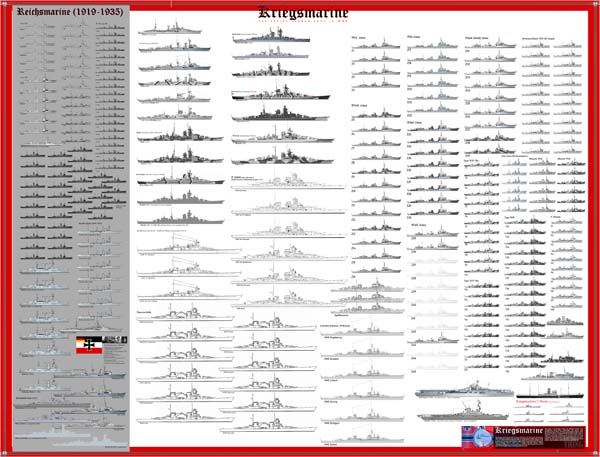
“rear thing” poster of the Kriegsmarine, V1. Capital ship at the center, including Plan Z ones.
On this, only 82 were realized, but few of the capital ships. The ambitious plan was born from the Anglo-German 1935 naval agreement, which de facto replaced Germany under the limitations of the Washington treaty, not Versailles, and authorization to reach 35% of RN tonnage. Plan Z was scheduled to be completed in 1946 at the earnest, with other dates suggested by various authors given the state of German naval industry at the time. Capital ships represented a massive investment in infrastructures but Hitler always regarded the Kriegsmarine or a mere auxiliary, an “hinderhance to france and Britain” whereas he regarded the success of the land war, supported by the Luftaffe, as paramount and more urgent, in the west first, and east second. The Navy had no part in it. The Kriegsmarine, despite all efforts by admiral Raeder, in charge from 1935, remained the poor child of German Military thinking (and spendings).
 Therefore, when was broke out in 1939, Plan Z was just getting started. The next pair of Battleships planned, the Bismarck class, was delayed to the point KMS Tirpitz was only operational in 1942. In September 1939 when Poland was invaded, only two fast battleships were freshly in service, and three commerce raiding cruisers, two heavy cruisers, five light cruisers and about sixteen destroyers.
Therefore, when was broke out in 1939, Plan Z was just getting started. The next pair of Battleships planned, the Bismarck class, was delayed to the point KMS Tirpitz was only operational in 1942. In September 1939 when Poland was invaded, only two fast battleships were freshly in service, and three commerce raiding cruisers, two heavy cruisers, five light cruisers and about sixteen destroyers.
 Blohm & Voss fast battleship 27,300 tons, 25 knots hull with 10 x 34cm proposal. See also
Blohm & Voss fast battleship 27,300 tons, 25 knots hull with 10 x 34cm proposal. See also
A “pocket navy” just good enough for the Baltic, inferior to the Marine Nationale, the Soviet Navy (on paper as we talk here of the Baltic Fleet alone), and lightyears from the “big three”, US, UK and after the iron pact, Japan and the mighty IJN. U-Boats were so few they were still not a thing. Arguably S-Boote and R-boote were more promising. Therefore there was no choice but to start a serie of commerce raiding operations as there just was no mass to envision classic naval battles, Jutland style. The story is well known. After lackluster results, Raeder was dismissed in 1943 and replaced by Dönitz, U-Boats were given all priority. Even the unique carrier Graf Zeppelin, so close to completion, was delayed until the end of the war. The story of German capital ships remains the big “what if” of world war two.
Early Projects of the Reichsmarine

Panzerschiff A concept
Before 1935 and the anglo-german naval treaty, the Versailles treaty was just crushing to any potential resurgence of a German Navy. The powerful instrument of 1914, forged by Tirpitz under the generous funding and constant drive of Kaiser Wilhelm II, was a giant of a Navy. The largest ever of the German speaking world. It fought many “cavalry battles” (led by battlescruisers) until the giant clash of Jutland in May 1916, which ought to be decisive, and was claimed as a tactical victory for the German Empire (by the number of ships sunk), and yet a complete strategic defeat. After this, the might German battleship fleet stayed in ports, while U-Boats gained a new interest thanks to their impressive beginnings.
In 1918 was planned a last hurrah, but many crews, demoralized after two years of inactivity while their families were starving, led by men seduced by the alternative of the Russian revolution, led to wholesale mutiny. The last battle of the Kaiserliches Marine petered out. By treaty, the might fleet was to be carved up between entente power as compensation, while the bulk would be led to the cold waters of Scapa Flow. There, after more inactivity and reduced crew (again to avoid mutinies) the proud Hochseeflotte scuttled itself on 21 June 1919.
The Versaille treaty, the same year, accepted with a heavy heart by German officials, reduced the new German Navy (later called the interim navy, then Reichsmarine) to six battleships, six cruisers, 12 destroyers, and 12 torpedo boats.
This could seems generous, but the battleships autorized were the ones spares the trip to Scotland: The latest and in better shape pre-dreadnought. Unlike all other powers capped by the Washington treaty which modernized their WWI dreadnoughts, Germany had ships only comparable to what had Scandinavian powers at the time: Coastal armoured defence ships. The new Reichsmarine was reduced to the size of the Swedish Navy. There was on top a watchful commission, which also observed adherence to a ban on submarines, aircraft and tanks as well, and forbade the construction of new ships until those authorized, all built before WWI, reached their service limits to justify a replacement. And there was also a 10,000 tonnes limit to any new construction.
Crippling as it may be, this did not prevented German admirals to try to make their way around these issues and “play by the rules” albeit to their own tone. The venerable Hans Zenker worked on this. Already at the admiral staff in 1917, he was probably the most respected by his peers when taking the head of the Reichsmarine as Chef der Marineleitung in 1924–1928, succeeding to Paul Behncke. Zenker was the one that devised a plan in case of a new war to at least leaving the Navy play its role with a fighting chance. He envisioned early on a new type of commerce raider…
German Battleships Specifics
Armaments
Germany was famously late in gun calibers in WW1 mostly due to the adherence to a simple principle that accuracy was almost nil at very long ranges and by closing the distance, with lighter, faster-reloading guns, chances of hist greatly augmented (for German battleships). Thus, from 21 to 24 to 28 cm, gun calibers stayed pretty modest. It would take the Kaiser class commissioned in 1915 to swap to the 12 inches (30 cm) caliber whereas the RN already commissioned ships armed with 13.5 inches main guns back in 1912 and were about to commission a new serie armed with 15 inches guns.
Germany only closed the gap with the Bayern class with the same 38 cm caliber by skipping a step. These were the last German battleships in service for the Imperial German Navy but certainly not the last designed. The famous L 20e α-class battleship planned in 1918 were already close to 50,000 tonnes fully loaded, and jumped to a superior caliber again, the 42 cm (16.5 in) SK L/45 guns to retake the advantage, albeit it is unknown how much the RN plans for the 46 cm or 18 inches battleships and battlecruisers also planned that year were known.
By design, the Versailles treaty forbade anything better than a 28 cm caliber for any new capital ship after 1920, which on a 10,000 tonnes design also mandatory, only meant building some sort of coastal battleships. Still, this caliber was put to good use for a serie of “panzerschiff”, the famous Deutschland class, protected cruisers with a heavy battery and then after tonnage was lifted in 1935, the Scharnhorst class, which to gain time, just retook the same turret design but adding an extra one, with an unmatched speed and greater secondary armament and AA to boot. This was just the start. From 1924 already, Krupp proposed larger gun designs, notably a 305 mm (12 inches) early on, and there was already experience designing the 38 cm of the Bayerns and all the work already made for the L 20e α.
However when PLAN Z was adopted in 1936, Krupp continued work on successor guns for the next class after the Bismarck, and the naval staff seeing these proposals considered 450mm (17.7″) and 500mm (19.7″) guns prior to WWII. And for later designs of the H-series battleship it was fixed at 480mm (18.9″) and then either 508mm (20″) or 510mm (20.1″) guns. The 460mm (18.1″) were not considered. Krupp worked however on 45 cm, 50 cm and 53 cm guns and related turrets. The 48 cm gun was for the highly academic H43 study as were the highly improbable 508 mm and 51 cm guns. The Gerat 36 21″ L52 gun was the largest tested.
In all occurence until the war started, Germany was not suppose to field anything larger than a 406 mm as defined by the Washington Treaty. Even the H39 battleships which tonnage was way above all limits, still stuck to that caliber, and was at least compliant treaty wise, less by choice than realism. Their guns design started in 1934 but it was intended to rebore it to 420 mm in the 1940. Same option was given for the Scharnhorst, equipped with 38 cm guns in twin turrets, but this was never carried out.
Krupp 28 cm SK C/28

The Deutschland class, the famous “pocket battleships” taunted by the press at the time, carried almost as much firepower as two pre-dreadnoughts with their six 28 cm guns. They had a main battery of SK C/28 guns mounted in two triple turrets with independent elevation fore and aft. Turrets were of the Drh LC/28 type with a fantastic elevation of 40°, for an impressive top range of 36,475 m (39,890 yd). They were designed to cripple a County class heavy cruisers, limited to 28 km and this was even better than the Queen Elisabeth’s own BL 15 in guns, at 33,550 yards (30,680 m) for the Mk XVIIB/Mk XXII streamlined shell. They fired a 300 kg (660 lb) AP shell at 910 meters per second (3,000 ft/s), 630 rounds stored in peacetime, 720 shells from 1939. This was demonstrated during the battle of Rio de la Plata, when taking on three cruisers, one heavy and two light with relatively good results. Later Scheer and Lützow had less occasions to shine.
Krupp 28 cm SK C/34

The new step were the guns fitted on the Scharnhost class battleships, Krupp 28 cm (11″) SK C/34. They were compatible with the same shells, but the barrel was much longer. They had a better high muzzle velocity and projected light-weight shells at very long range, wtill with good penetration power, but poor performance against deck armor. They weighted, including the breech 111,739.6 lbs (53,250 kg) for 607 in (154.415 m) long overall, 571.1 in (14.505 m) barrel. Crucially they had a rate Of Fire of 3.5 rounds per minute.
They fired fired the APC L/4,4: 727.5 lbs. (330 kg), HE L/4,4 base fuze: 694.4 lbs. (315 kg), HE L/4,4 nose fuze 3: 694.4 lbs. (315 kg) and HE L/4,4 nose fuze AA 4: about 685.0 lbs. (311 kg). The APC had the best muzzle velocity at 2,920 fps (890 mps). More importantly, range was now of 40,930 m (44,760 yd) at 40°. So they could keep anything as fast at bay. To compare their planned rivals, the Dunkerque class battleships, which had a larger caliber (33 cm/50 Modèle 1931) and the same range of 41.700 m with SAP, 40.600 m with HE. Now the KGV class had an equally “light” caliber of BL 14-inch/45 Mk VII (356 mm) was below this at 38,600 yd (35,300 m) at 40° but this did not prevented a clear cut victory in a duel with Scharnhost in December 1943, in appealing weather.
28.3 cm Krupp C26L Design, 1926


Drh.L. 28.3cm/L54.5 C/33 C2 twin turret May 1933 design.
30 cm Krupp (never developed further)

Twin turret design Krupp C26 design 1926

Triple turret Krupp C26 design 1926
See more here
These were planned for the “Flottenkreuzer” projects.
38 cm SK C/34:

To start with, Krupp could already work from the Bayern class but as 47 cal. long. These 38 cm (14.96″) SK C/34 were 50 caliber instead and had been completely redesigned. Each of the new Bismarck class was to carry eight of these in four twin turrets, in a balanced, albeit relatively rarer arrangement of four forward, four aft. The Guns had a Breech end-piece and block supporting piece with horizontal sliding breech block and each weighted 244,713 lbs. (111,000 kg), being 772.8 in. (19.630 m), 724.6 in. long.

ONI depiction of the Bismarck. Note the three twin 6-in turrets, and eight 105 mm DP mounts. A lot for superficial similarities with the 1916 Bayern class in the general design.
Rate Of Fire was surprisingly good for that large caliber at 2.3 to 3 rounds per minute and it fired an APC L/4,4: 1,764 lbs. (800 kg), HE L/4,5 base fuze, HE L/4,6 nose fuze 3a, HE L/4,6 nose fuze AA 4a. Unlike the 28 cm turrets they could only elevate to 30° but still had a range of 36,520 m (39,940 yd) an muzzle velocity of 820 meters per second (2,690 ft/s) on average that can cause untold damage. To compare, their intended for wads the Richelieu class, which had the same caliber and number but in two quad turrets forward. The 380 mm/45 (14.96″) Model 1935 had a slower rpm of 1.3-2, but better elevation and greater range at 35 degrees, 45,600 yards (41,700 m), provided the fire control was efficient.
40 cm Krupp C34 F4

Rare Krupp quad turret design planned for the H class as alternative to twin 45 cm turrets, 1938.
15 cm SK C/28
There was a battery of eight 15 cm SK C/28 guns: They were fitted in single MPLC/28 mounts due to the lack of space for twin turrets, and arranged amidships along the superstructure. Elevation was 35°, depression −10°, range 25,700 m (28,100 yd) and a total of 800 rounds of ammunition were carried in peacetime, yet again raised during the war to 1,200 rounds. These were HE shell weighing 45.3 kg (100 lb), existing the barrel at 875 m/s (2,870 ft/s).
15 cm SK C/28

The turrets and pedestal mounts enabled a depression/elevation of −10°/40° down to 35° for the single mounts. They fired a 45.3 kg (99.87 lb) shell at a rate of 6–8 rounds per minute. Barrel life time was expected to be 1,100 rounds. The pedestals guns range reached 22,000 m (24,060 yd), while the turrets, which could elevate further, reached 23,000 m (25,153 yd). Ammo supply range was between 1,600 and 1,800 shells total so around 133–150 shells per gun.
105 cm SK C/28

The Deutschlands, Scharnhorst and Bismarck class all had the same anti-aircraft battery of 10.5 cm C/33 L/65 guns in twin mounts completed by a variable number of 3.7 cm L/83 FLAK 36/38 in twin mounts and 2 cm FLAK 36 guns as designed. Often quad Flakvierling were added during WW2.
These 10.5 cm guns were at the high er level of AA protection, with a rate of fire of 15–18 rpm and ceiling of 12,500 m (41,010 feet). They were placed on semi-open Dop.L.C/31 twin mounts on the upper structure and had a depression/elevation was −8° +80°, maximum range of 17,700 m (19,357 yd) at 45°.
Propulsion
“Panzerschiff” diesel powerplant
Sun Tse allegedly said “be like water, fight the weak, flee the strong”. The Deutschland class were inspired by this concept but still needed much more range as any oother ship type due to their extensive area of operation, and few ports available to resupply, as well as supprot ships. It was the main reason of their adoption of diesel engines, more frugal than steam turbines. However they lacked the raw power of steam turbines. They had four sets of 9-cylinder, double-acting, two-stroke MAN diesels, taking less space than the full combo boilers+ turbines, saving weight for more ammunition and fuel oil.
They were connected to an AG Vulcan transmission. Two diesels were paired for each propeller shaft. These were classic three-bladed 4.40 m (14 ft 5 in) props, larger than the 3.70 m (12 ft 2 in) propellers initially intended. Total output planned was 54,000 metric horsepower (53,261.3 shp; 39,716.9 kW) for a top speed of 26 knots (48 km/h; 30 mph). Most heavy cruisers could catch her at 30+ knots, but they had the artillery to scare them out. Total output achieved in reality was down to 48,390 PS (47,730 shp; 35,590 kW) but Graf Spee managed 29.5 knots as recorded. It is very likely the next Panzerschiff would have the same arrangement, but with more sets.
The very fast battleships: Scharnhorst class

Diesel propulsion was planned for a time (after all, Germany was a pioneer for its battleships already before WW1), perfect for Panzerschiffe, long range commerce raiders. But the role of the next Scharnhorst shifted to classic battleships in 1935 as limitations were lifted. It was decided to give them a more suitable superheated steam propulsion, allowed by a greater size. To reach the 35 knots expected, they needed three times more output. They also signed a return to the triple propellers arrangement of WWI german battleships. In total, 40,000 hp per shaft. Scharnhorst diverged with three imported Brown, Boveri, & Co geared steam turbines while Gneisenau had three Germania geared turbines.
They also had larger propellers at 4.8 m (15 ft 9 in) in diameter and the turbines were fed by 12 Wagner ultra-high-pressure oil-fired boilers with a working pressure of 58 standard atmospheres (5,900 kPa) at 450 °C (842 °F) for a grand total of 160,000 metric horsepower (157,811 shp; 117,680 kW), 165,930 PS (163,660 ihp; 122,041 kW) at 280 rpm reached on trials, and a top speed of 31 knots (57 km/h; 36 mph) as designed but 31.3 to 31.5 knots on trials. For endurance with 2,800 metric tons (2,800 long tons; 3,100 short tons) of fuel oil or up to 5,080 metric tons (5,000 long tons; 5,600 short tons) they coukd reach 8,100 nautical miles (15,000 km; 9,300 mi) at 19 knots (35 km/h; 22 mph). They also had an important Electrical power from five electric units comprising each four diesel generators and eight turbo-generators. To compare this was 10,000 nmi (19,000 km; 12,000 mi) at 20 knots (37 km/h; 23 mph) with the diesel-equipped Deutschland.
How to power 50,000 tonnes: The Bismarck class

The three props arrangement is typical of German battleships, but Dr. Ballard, which rediscovered the Bismarck, argued this caused a keel structural weakness.
The Bismarck-class in many ways repeated the same powerplant as the Scharnhorst but on a large scale, with three sets of geared turbine engines. Bismarck had Blohm & Voss turbines, Tirpitz Brown, Boveri, and Co. ones, purchased before the war. Propellers were smaller at 4.70 m (15 ft 5 in) in diameter. The high and medium-pressure turbines ran at 2,825 rpm, low at 2,390 rpm, fed by twelve Wagner ultra high-pressure water-tube boilers. The initially planned electric-transmission turbines rated for 46,000 shp (34,000 kW) apiece had too greater weight to be adopted. The geared turbines were both lighter with a slight performance advantage and a more robust construction.

Top speed was 30 knots (56 km/h; 35 mph) based on 163,023 PS (160,793 shp; 119,903 kW) on Tirpitz or 148,116 for Bismarck. They also carried 3,200 tons of fuel oil, up to 6,400 tons with extra fuel bunkers and even 7,400 tons. Tirpitz carried a max of 7,780 tons. At 19 knots this made for 8,525 nautical miles (15,788 km), 8,870 nautical miles (16,430 km) for Tirpitz. However the axial shaft arrangement gravely weakened the keel. It’s not use of the same arrangement would have been kept for the next H-class. As for extra power, they had two 500 kW diesels and five 690 kW turbo-generators from Garbe, Lahmeyer & Co. for 7,910 kW at 220 volts.
Radars
 Installation of radars started from 1937 on KMS Deutschland. This was the first type in service, the FuMG 39 Seetakt, which had a quite reduced range and poor accuracy. In 1939, the FuMG 39 was replaced by the FuMO 22 radar, a more mature system. It was installed also in 1939 on her sisters. By late 1940 however Admiral Scheer obtained instead the FuMO 27 radar (photo NH 96443 navsource, here on top of Prinz Eugen’s director). In 1941 she had instead the FuMO 26 radar installed as well as the FuMB 4 Sumatra and FuMB 7 Timor ECM suites. Lützow had the same in 1942. They ended the war with these systems.
Installation of radars started from 1937 on KMS Deutschland. This was the first type in service, the FuMG 39 Seetakt, which had a quite reduced range and poor accuracy. In 1939, the FuMG 39 was replaced by the FuMO 22 radar, a more mature system. It was installed also in 1939 on her sisters. By late 1940 however Admiral Scheer obtained instead the FuMO 27 radar (photo NH 96443 navsource, here on top of Prinz Eugen’s director). In 1941 she had instead the FuMO 26 radar installed as well as the FuMB 4 Sumatra and FuMB 7 Timor ECM suites. Lützow had the same in 1942. They ended the war with these systems.
In late 1939, Gneisenau and Scharnhorst were equipped with the FuMO 22 radar replaced in 1941 on Gneisenau by the FuMO 27 and in 1942 her sister Gneisenau received a second FuMO 27 as well as the FuMB 6 Palau ECM suite. Scharnhorst the same year had the FuMO 22 replaced by two FuMO 27 radars like her siuster and received also the FuMB 6 Palau ECM suite, and in 1943 before she was sunk at the north cape, the class lead ship had the FuMB 4, FuMB 7 ECM suites installed. The ships detected themselves by radar as the weather was poor to say the least in December in the north Atlantic. The FuMo 27 was a 4meters wide mattress type, usually added in front or on top of a telemeter. The FuMO 212 or 213 of the Bismarck class were the 3m diameter parabolic dish antenna added to globe-like 3-D, stabilized AA directors.
As completed both Bismarck class battleships were provided by one FuMO 23 radar, completed by two FuMO 21 radars. Tirpitz when completed in 1942 instead had four FuMO 27 radars. Shortly before her first sortie, Bismarck received a fourth radar, a FuMO 23 radar unit, making for two of these and two FuMo 21.
Late 1941 Tirpitz received the FuMB 4 and FuMB 7 ECM suites and by June 1944 all four radars were replaced by FuMO 26 and FuMO 213 with a new ECM suite composed of FuMB 6 models. As completed and planned the Z plan H class would have four FuMO 27 radars, as well as the O class battlecruisers.
Aviation
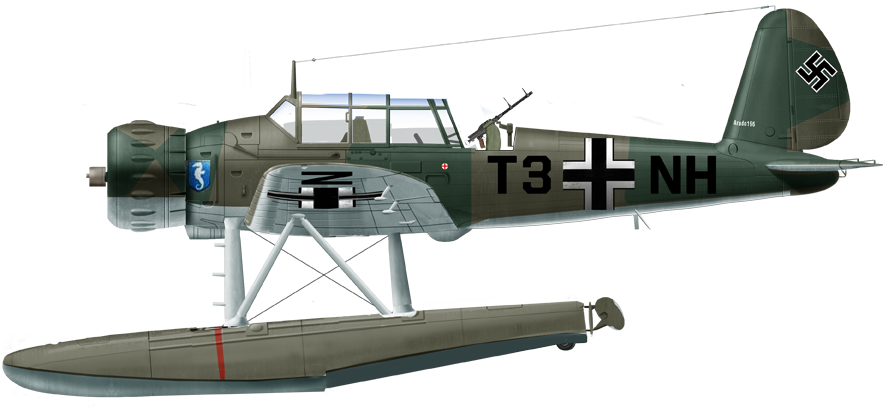
196 A3 Bordflieger Gruppe 196, KMS Scharnhorst, Brest 1941
The Deutschland class as completed had nothing bbut in 1934-1935 a catapult was installed to operate two seaplanes of the Heinkel He 60 type, biplanes. This was an arado for Scheer and Lützow before they were removed for radars only in 1943-44. Scharnhorst as completed had two catapults, 2-4 seaplanes of the Arado 196 type, whereas Gneisenau had instead three Heinkel 114 parasol seaplanes. Thewe were just terrible, and replaced by the Araado 196.
In the summer of 1939, Scharnhorst as reconstructed, had her hangar lengthened to carry 5 seaplanes (3 in hangar and 2 on catapult). From late 1939 ro early 1940, Scharnhorst had her catapult fitted on “C” turret removed. She had the same amidship catapult and four 4 seaplanes. Gneisenau also had the same catapult removed but only carried two seaplanes. But by 1942, her hangar was also enlarged to carry 3 seaplanes, 1 on amidship catapult.
The Bismarck class from the start had two catapults amidships and two hangars for four seaplanes of the Aradao 196 type, two on catapults externally, launched on either side, and two fodled in hangar.
H class battleships would have one catapult and four seaplanes with the Arado 196 whereas the O class battlecruisers would have two catapults placed like on Bismarck and four seaplanes, also Arado 196. This really was the go-to spotter/reconnaissance model for the Kriegsmarine in 1940.
Ship’s List
 Deustchland class
Deustchland class
Deustchland, Adm. Graf Spee, Adm. Scheer. Cruisers or Battleships ?
Compromised ships for the Interim Navy
The three units of the Deustchland class (Deustchland, Admiral Scheer, Admiral Graf Spee), called “panzerschiff” for propaganda purposes, translated a “pocket battleships” in the press, were not battleships but rather standard cruisers with a heavier than normal artillery.

Compromises indeed were made in the face of the limitations of the Treaty of Versailles: 10,000 tonnes (tonnage of a heavy cruiser). In order to remain within this limit while possibly having any military value as battleships, they were the first products of the tactical conceptions of Erich Raeder, a champion of commerce raiding warfare. Thus these ships were designed to attack trade and facing all kind of escorting vessels in two ways: Fight the weak (cruisers), with a superior fire power, range, and equal protection, or flee the strong (true battleships) thanks a cruiser’s speed, 30 knots instead of 20-25.
The Deutschland did not take yet into account a largely paper-borne generation of rapid battleships still blocked by Washington’s moratory. They would eventually make this class vulnerable. These interwar limitations were perfectly demonstrated during the events of the Graf Spee and the Battle of the Rio de la Plata in 1939, soon throwing a veil of suspicion over the concept of these ships and surface raiders as a whole in the eyes of Hitler.

KMS Admiral Scheer before the war
Designed as pure commerce raiders, they were meant to prey in trade lines and flee battleships, while still being able to deal with any escorting cruisers. For Graf Spee, sent ahead of a possible war, she was dependent on pre-positioned supply ships, as the famous Altmark. Graf Spee’s commander, Hans Langsdorff, played ae cat and mouse game with allied fleets, sinking 50,000 tons of merchant tonnage in Southern hemisphere before being cornered in Uruguay.
Deustchland, for her part, sank 7,000 tons and the Scheer 137,223 tons. After the misfortune of the Graf Spee, Hitler ordered that KMS Deustchland to be renamed Lützow, for an obvious question of national prestige in case of similar fate… Admiral Scheer and Lützow took part in more ill-fated convoy attacks from Norwegian fjords but eventually succumbed to the RAF, as did Tirpitz by Barnes Wallis bombs.
KMS Deutschland specifications |
|
| Displacement | 11,700t/16,200t FL |
| Dimensions | 155.10 x 14.30 x 6.60 m () |
| Propulsion | 3 shafts diesels 9-cylinder MAN, 54,000 hp |
| Speed | 28 knots (42 km/h; 20 mph) |
| Armament | 2×3 280 mm, 8x 150 mm, 8×2 105 mm AA, 8×2 37mm AA, 2×3 533 mm TTs |
| Armor | Belt: 76 mm (3 in), Deck: 38 mm (2 in), Turrets 140mm (5.8 in), Conning tower: 152 mm (6 in) |
| Crew | 1150 ??? |

KMS Graf Spee in 1939, with its superstructures-only green camouflage

KMS Lützow en 1944 (former Deutschland) with the standard straight pattern, shades of gray and blue of the Northern Sea, old author’s illu.
 D class Panzeschiff (1934)
D class Panzeschiff (1934)
The D-class cruisers were two German heavy cruisers (not battleships), classified however as panzerschiffe (“armored ships”) by the Reichsmarine as improved versions of the Deutschland-class. They were authorized by Adolf Hitler in 1933 to counter a new French naval construction program. They tore down the Versailles treaty with a tonnage double of what was authorized at 20,000 long tons (20,000 t). Hitler however only allowed increases to armor, not armament. They were laid down in February 1934 but nothing was done when cancelled after a deep revision of the design after the 1935 anglo-german naval treaty. It was estimated the rewored Scharnhorst-class would be more efficient against the French Dunkerque-class battleship.

KMS Ersatz Hessen c1935, D class design Panzerschiff.
Compared to the Deutschland class they had twice the displacement at 20,000 long tons (20,000 t) and were almost as long as the following Scharnhorst class at 230 m (754 ft 7 in) overall, 225 meters (738 ft 2 in) at the waterline but were much thinner, cruiser like wirth a Beam of 25.5 m (83 ft 8 in), almost a 1/11 ratio excellent for speed, not so much for agilitty.
They had also a 8.5 m (27 ft 11 in) draft. Installed power was of 125,000 PS (123,000 shp) mixing Steam turbines with boilers and diesels. Top speed was superior to the Deutschland at 29 knots (54 km/h; 33 mph). Protective armament was at first four 28 cm (11 in)/52 SK C/28 guns (2 × 2) and later the design was revised shortly before cancellation, with three turrets, just like the Scharnhost class. Secondary battery was about the same with eight 15 cm (5.9 in)/55 SK C/28 guns in four twin turret and four twin DP 10.5 cm (4.1 in)/65 SK C/33 AA mounts.
Protection was better than the Deustchland also, and closer to their “panzerschiff” denomination indeed. The belt for example was protected by 220 mm (8.7 in), immune to 8-inches AP shells for example. Decks were also better protected, the upper deck being deck: 35 mm (1.4 in) and below and armoured, waterline deck of 70 to 80 mm (2.8 to 3.1 in). The turrets and their barbettes were well protected at 200 to 360 mm (7.9 to 14.2 in) and the Conning tower was 300 mm (12 in) thick. The central Citadel was constituted of longiutudinal and transverse bulkheads that were 50 mm (2 in) thick. So they corresponded to the standards of WW1 battlecruisers.
 P class Panzeschiff (1937)
P class Panzeschiff (1937)
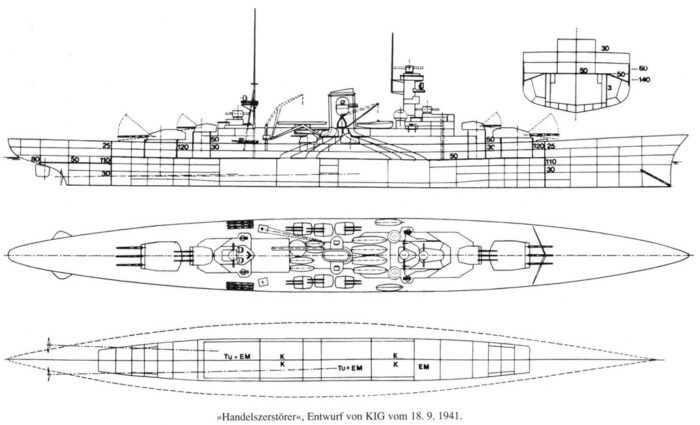
The P class was a planned group of twelve heavy cruisers planned for PLAN Z under Raeder, for the Kriegsmarine. True successors to the Deutschland-class cruisers, they had a design work starting in 1937, continuing until 1939 and something like twenty designs submitted, nine considered, three selected as final contenders.
One design was armed with six 283mm main guns in a single triple turret forward one aft, like the Deutschlands, and as wanted by Hitler. They had two 150mm twin secondary gun turrets, above and fore of the aft main 283mm main turret, the other front of the fwd main gun turret. This was beamier design, albeit still very slender compared to the Scharnhorst class. It also had 2 seaplanes on the fantail instead of amidships.
The final design adopted had also two triple turrets but with the same six 28 cm (11 in) quick-firing guns of the preceding Deutschland class and they were also designated Panzerschiff (armored ship). Preliminary names fore orderes were P1–P12. They were improved designs of the previous D-class canceled in 1934. They were assigned to shipyards in 1938 when cancelled also, for the new O-class battlecruiser design.
Displacement wise they were larger than the D-class, 2.5 times more than the Dutschland at 22,145 t (21,795 long tons) standard and 25,689 t (25,283 long tons) full load, 230 m (754 ft 7 in) long overall and much bearmer than before at 26 m (85 ft 4 in), draftier also at 7.20 m (23 ft 7 in).
Installed power was all-diesel unlike the D-class but with no less than twelve MAN diesels total fpor a combined power of 165,000 PS (163,000 shp). These were bnot only for speed (33 knots (61 km/h; 38 mph)) but also range, which was exceptional at 25,000 nmi (46,000 km; 29,000 mi) at 13 knots (24 km/h; 15 mph). It was theorized they would be deployed without support to attack global trade.
In addition to their six 28 cm (11 in) guns and four 15 cm (5.9 in) guns they had four 10.5 cm (4.1 in) AA guns, four 3.7 cm (1.5 in) AA guns and six 53.3 cm (21 in) torpedo tubes. Protection was seriously decreased compared to the D-class, down to just 80 to 100 mm (3.1 to 3.9 in) for the barbettes, 40 to 120 mm (1.6 to 4.7 in) for the belt, 70 mm (2.8 in) for the armoured deck with a thin torpedo bulkheads of 30 mm (1.2 in). Cruisers indeed. For recce they had two catapults and two Arado 196 seaplanes.
So in the end, of built, they would have been much faster than the Deustchland, with much more range, and even more capable of leaving behind any chasing cruiser. But one hit by a Swordfish and they would have been easy preys. They clearly lacked protection and were more cruisers than capital ships.
 O class battlecruisers (1937)
O class battlecruisers (1937)
The O class was a planned class of three battlecruisers for the Kriegsmarine, pompted by a perceived lack in numbers when compared with the British Royal Navy, even based on the 1935 authorized 35% tonnage equality, the the O class were a suggestion to modify the P-class cruiser design, upgraded with 380 mm (15 in) guns instead of 283 mm (11.1 in) and in three twin turrets. They were basically a variant of what was planned already for the Schanhorst. Emphasis was to be given also on protection.
They were incorporated into 1939 Plan Z as the sole true “Battlecruisers”. In this plan it was theorized that aircraft carrier and H-class battleships would engage convoy escorts, whereas O-class battlecruisers would attack merchant ships. Their design reflected this intended role. The six 380 mm guns in three dual turrets was to strike rapidly ad decisively any escorting 8-inches armed (203 mm) armed British heavy cruisers but armour also immune to their shells but nothing above. They were not intended to duel against battleships albeit it was argued their 38 cm guns’superior range would be and advantage in that case, combined by their superior speed to all capital ships in the RN, the 23 knots QE and Revenge, 25 knots Nelsons, 27 knots KGV. They were planned and ordered, but construction sledom started due to lack of materials and other priorities for ship construction. Eventually they were also cancelled

Rendition of the fictitious “ägir” – WoW
Displacement wise, standard they were 28,900 long tons (29,364 t) and 35,400 long tons (35,968 t) full load so treaty-compliant with a fair margin (35k tonnes standard) and much longer than previous ships, including also the Schanhorst class. I fact even the Bismarcks, at 256 m (839 ft 11 in) overall, 248.2 m (814 ft 4 in) at the waterline for a generous beam of 30 m (98 ft 5 in), draft of 8.02 m (26 ft 4 in).
No only diesels here, it made no sense in their role, and so they mixed a single steam Brown, Boveri turbine set rated for 60,000 shp (45,000 kW) fed by four Wagner boilers and several MAN eight 24-cyl. diesels for a total of 116,000 shp (87,000 kW) for a top speed of 35 knots (65 km/h; 40 mph). So they were even faster than heavy cruisers of the time. Range was also good at 14,000 nmi (26,000 km; 16,000 mi) at 19 knots (35 km/h; 22 mph), compared to 8,800 nm on Bismarck. This was alsost double. The crew was amost 2,000 strong, with 65 officers and 1,900 men.
As said above the O class battlecruisers would have been armed with six 38 cm (15 in) SK C/34 guns, six 15 cm (5.9 in) guns in three twin turrets, eight 10.5 cm SK C/33 AA in four twin mounts, eight 3.7 cm SK C/30 AA, same config. and twenty 2 cm SK C/30 AA in twin and single mounts, likely if completed, with extra Flakvierling mounts. They also had two triple banks for 53.3 cm (21 in) torpedo tubes.
Protection was good, albeit not as goos as the D-class Panzerschiff. In fact it was quite light in case of any encounter with a battleship.
The Belt was 190 mm (7.5 in) thick, armoured deck 80 mm (3.1 in), the turrets were protected by 210 mm (8.3 in) and the longitudinal torpedo bulkhead was noted at 45 mm (1.8 in), so were the transverse bulkheads probably.
They had the same double catapult arrangement as Bismark, both at the center amidship with three hangars for Arado Ar 196 seaplanes.
 Scharnhorst class (1936)
Scharnhorst class (1936)
Scharnhorst, Gneisenau. 1935-1937
Battleships or Battlecruisers?
The two Scharnhorst class somewhat escaped classifications whe first planned. Now all authors agrees as them being fully fledge fast battleships. They were in essence a German answer to the French but not enabled by the 1935 naval agreement with the British. In fact they had been ordered earlier in February 1934 at Kiel, named after the famous generals of the Napoleonic armies and also to honor the memory of Admiral Von Spee’s Pacific fleet squadron’s armoured cruisers. Unlioke the French which had four 33 cm main guns, they had twelve 28 cm but equal range to the French.

Original blueprint of the Scharnhost class, side elevation

KMS Scharnhorst prewar – Bundesarchiv
Still they carried a faster artillery, had a greater AA and were very much designed equal part for commerce raiding and battle after many design revisions. Their artillery was vastly superior to cruisers, but insufficient to face modern battleships, not to mention their protection, inneffective against 16 in shells. Their speed remained their best protection, but in case of poor visibility their extra artillery range was of no use as shown by the battle of the north cape.
Raeder planned a variant with 38 cm turrets, but this caliber was reserved in priority for the Bismarck class. The planned upgrade in 1942 was postponed and never applied. Instead they had their bow rebuilt in to a clipper one, and other detailed modifications. Great speed and superior artillery range were considered a net advantage in any encounter. They could choose the tempo of the engagement, at least on paper.

Scharnhorst’s 280mm turrets
In 1938-39, their seaworthiness was improved by the addition as seen above of an Atlantic type clipper bow, better suited with an overall length increased to 235 meters. They had catapult and hangar changes, mast moved and rebuilt, extra 20 mm AA FLAK added, also triple 533 mm torpedo tubes banks to fight off destroyers. From October 1939, the “terrible sisters” started to attack convoys in the North Atlantic. They battled HMS Rawalpindi, an AMC (Armed Merchant Cruiser) for almost one hour courageously defending its convoy and destroyer HMS Glorious, an aircraft carrier, so two defenseless preys essentially. In 1940 also off Norway Gneisenau at least exchanged volleys with a perfect match, the battlecruiser HMS Renown and this was mostly a draw albeit she took hits (with 16-in shells) for potentially severe damage and long repairs in Kiel after hitting a magnetic mine. In that case, she disengaged despite her artillery had a longer range. It mattered in pristine conditions like in the Mediterranean, or baltic in summer, but not in the north Atlantic at the best of times.

Scharnhorst in Port
On June 8, 1940 as said the terrible sisters destroyed the carrier Glorious only escorted by two destroyers, both also sunk. Gneisenau was torpedoed at the end of the month and immobilized for repairs and from January to March 1942, Operation Berlin saw them sinking 22 ships, like wolves in a sheep shed. This was by far their best commerce raid. Based in Brest, they were repeatedly attacked by the RAF, for good reasons, until it was decided to move them back to Germany, meaning they had to cross the channel, a very risky proposition as the RN and RAF had a scenario and contingency plan, for this.
The Führer no longer believed in 1942 they could be of any use in the fight against the Atlantic convoys, especially after the loss of Bismarck, and ordered them to be transferred to Norway. Operation Cerberus despite all expectation, was a success, mostly due to blunders and miscommunications on the British side, their great speed, and despite the courage of pilots. On February 12, 1942 with the heavy cruiser Prinz Eugen, which left Bismarck shortly before destruction, had a Me 109 fighter squadron over them all the time and especially close to Calais in broad daylight. Destroyers attacks failed also due to heavy weather with HMS Worcester close enough to be hammered by artillery. Gneisenau however hit a magnetic mine laid by the RAF in the Skagerrak.
The RAF latter hammered with heavy bombers Gneisenau in Kiel on 26 February 1942.

Gneisenau after her second bow refit in 1942
It was planned to replace her prow, destroyed by the explosion by an even longer one, to compensate the weight of the new 38 cm turrets that were planned to be installed but instead the original replacement turrets were transported to Norway and used to defend the fjord hosting Tirpitz and Scharnhorst. In February 1943 the latter famously failed in a convoy attack at the Battle of the Barentz Sea and Hitler in a rage, ordered to stop work on her sister ship and even threatened to scrap the entire surface fleet and concentrate on submarines as suggested by Dönitz. Gneisenau remained in Gotenhafen for the rest of the war, deprived of her artillery, scuttled in March 1945 to block the entrance.
Scharnhorst meanwhile in Norway only made two sorties against convoys, always well protected by the Royal Navy and in some cases, the US Navy. At the North Cape on December 22, 1943, an important convoy (JW55) was reported, weakened already by the luftwaffe and submersibles. Scharnhorst sortied alone, Tirpitz being under repair, escorted by five destroyers under Rear Admiral Erich Bey. He splitted his forces, with the destroyers being detached to try to find the convoy while he would attempt to take on the three cruisers of Admiral Burnett’s 10th Squadron (Belfast, Sheffield, Norfolk).

Scharnhorst however was soon overwhelmed by accurate fire, despiite its advantage on paper and withdrew from the fight after a brief exchange, as its role was to lure these out, towards pre-positioned U-Boats and way from the convoy. The first objective being the convoy, she resumed her trip due north in abysmal weather and wasted fuel trying to locate the convoy. Meanwhile, the 10th Squadron was joined by the destroyers of 36th Division and all guided by HMS Norfolk’s new radar, managed to locate and fire again on Scharnhorst. After a fierce exchange, Bey decided once again to withdraw further south, crossing the path of HMS Duke of York, joined later by King Georges V. The trap was closed.

In common they had twenty 14 in (356 mm) opposed to six 11 inches (280 mm) of the Scharnhorst and guided by radar, they crossed her T. Soon Scharnhost lost her fire contol and two forward turrets. She managed to flee but too late. Duke of York’s volley made it into her engine compartment. Bey sent a last message to Hitler intended to “fight until the last shell”. This was an execution for the battleship, no dead in the water. It was estimated she received about 2,000 his bvefore being finished off by torpedoes, with 36 rescued. Bey went down with the ship and most officers.

Scharnhorst firing against HMS Glorious
Scharhorst specifications |
|
| Dimensions | 235 x 30 x 9.69 m (771 x 98 x 31.8 ft) |
| Displacement | 32,100 long tons (32,600 t), Full load: 38,100 long tons (38,700 t) |
| Propulsion | 3× steam turbines, 12 × Wagner boilers 151,893 PS (149,815 ihp; 111,717 kW) |
| Speed | 31 knots (57 km/h; 36 mph) |
| Range | 6,200-7,100 nmi (13,100 km; 8,200 mi) at 19 knots |
| Armament | |
| Armor | Belt: 350 mm (13.8 in), Deck 50-95 mm (2.0 to 3.7 in), Turrets 200-360 mm (7.9 to 14.2 in), CT 350 mm |
| Crew | 1,669 (56 officers, 1613 enlisted) |
| Aviation | 3-4 × Arado Ar 196A-3 |

KMS Gneisenau in november 1943, in the “Norway” pattern.
 Bismarck class (1940)
Bismarck class (1940)
Bismarck, Tirpitz
The most formidable battleship in the world, 1941.
Ordered in 1935 to 1937, launched in 1939 and 1941, the Bismarck and Tirpitz were the last battleships in German history. They were also the first undertaken since the Baden of 1917 with 38 cm gun turrets with the same AB-XY configuraration. These were stretched out fast battleships and were declared at 35,000 tonnes standard, but in reality had been laid down way above and jumped to 50,000 tonnes fully loaded.

Bismarck prow seen in Hamburg harbour, 1940.
This basically was the first class of plan Z, with 6 other to follow, the 40.6 cm armed H class. When Bismarck was admitted in active service on 24 August 1940, after four years of design and construction she wa staunted at the most powerful warship in the world but by crossing data to death until recent years, it is clear she does not even make it in the top five, and is even below its planned adversary, the lighter and faster Richelieu class. Protection was way better than on the Scharnhost, they had almost the same speed and had an impressive secondary artillery with average range but state-of-the-art fire control system and good radars from the start.
KMS Bismarck in service
KMS Bismarck, named after the German chancellor and architect of German unification in 1870 was the first in service, spent a few months in the Baltic, training for her first major sortie in the North Sea, May 1940. Commanded by Admiral Lütjens she was the centerpriece of Rheinübung, assisted by the cruiser Prinz Eugen. She left the Skagerrak and sailed due north, putting anchor in the fjord of Bergen, facing Scotland. Informed by local contacts in Sweden, the Admiralty had the confirmation of her presence in Norway by a spitfire sent for recognition.

Bismarck training in the Baltic
Thus a battle plan was developed to block her three possible paths to the Atlantic. The rest is history. Long story short, she was sghadown by British cruisers north of Scotland, intercepted by Hood and Prince of Whales, sunk the first, damaged the second, and later while sailing south to convoy lines, was attacked twice by Swordfish torpedo bombers, and with one lucky hit had her rudder damaged, starting circles. Prinze Eugen was sent to Brest, which she had now no hope to reach. She was caught by a battleship force comprising HMS Rodney and King Georges V, and hammered t death. Only a few were rescued. She was rediscovered in 1989 by prof. Robert D. Ballard (of Titanic rediscovery fame) in the Gulf of Gascony. In 2002 Canadian director James Cameron created a full documentary after exploring her wreck confirming the deah blow by torpedoes, not scuttling as claimed fo 60 years.
KMS Tirpitz in service
For her part the Tirpitz was named after the creator of the Kaiserliched Marine. She was launched on 1 April 1939 in Wilhelmshaven, baptized by Hitler and the daughter of Von Tirpitz. She entered service as late as February 1944 with a heavy AA and new radars and sent immediately to Norway, Faettenfjord (Trondheim), with final completion done there. She was to prey on norther route allied convoy and mobilize the Home Fleet in this area.
Her only raresorties due to increasing shortages of oil often resulted in failures or retreats after being signalled aircraft carriers, casting a shadow on all operations since the loss of the Bismarck. Well protected by nets and ASW mines, patrols in the fjord and on shore, AA protection on the heights and a nearby airfield, the “lonerly queen of the north” played her threat until the RAF managed to launched operations, once the Navy carriers failed to do some impression in three operations. Bombing raid, frogmen attacks (Operation Tile), midget subs (X1-8), were unsuccessful.
Due to fuel shortage, it was decided to move her further inland on a kind of “platform” dredged and flattened. In case of heavy flooding she would just sit in shallow waters, artillery still operational. However Bomber Command in November 1944 deployed modified Lancaster bombers loaded with Barnes Wallis ( “Grand Slam”, 9 tons) bombs, initially designed to break dams and destroy concrete bunkers. These basically created a localized earthquake. In one such raids, an ammunition store was hit, and completely detroyed her hull. She capsized, no longer in her safe spot, with the losst of 971 men and officers. Her wreck was gradually dismantled after the war by the Norwegians.
Bismarck specifications |
|
| Dimensions | 248 x36 x10.6 m |
| Displacement | 42,300t/52,600t FL |
| Crew | 2600 |
| Propulsion | 3 screws, 3 Brown-Boveri turbines, 12 Wagner boilers, 138 000 cv |
| Speed | 30 knots (55.58 km/h; 34.53 mph) |
| Range | 8,870 nmi (16,430 km, 10,210 mi) 19 knots (35 km/h, 22 mph) |
| Armament | 4×2 380 mm, 12×150 mm (6×2), 8×2 105mm, 8×2 37mm, 12 20mm AA, 4-6 hydroplanes. |
| Armor | Belt 317mm, deck 50mm, torpedo bulkheads 44mm, turrets 362mm, blockhaus 356mm |

The KMS Tirpitz in juin 1944, in her “Norvegian livery”.
 H class battleships (1942)
H class battleships (1942)
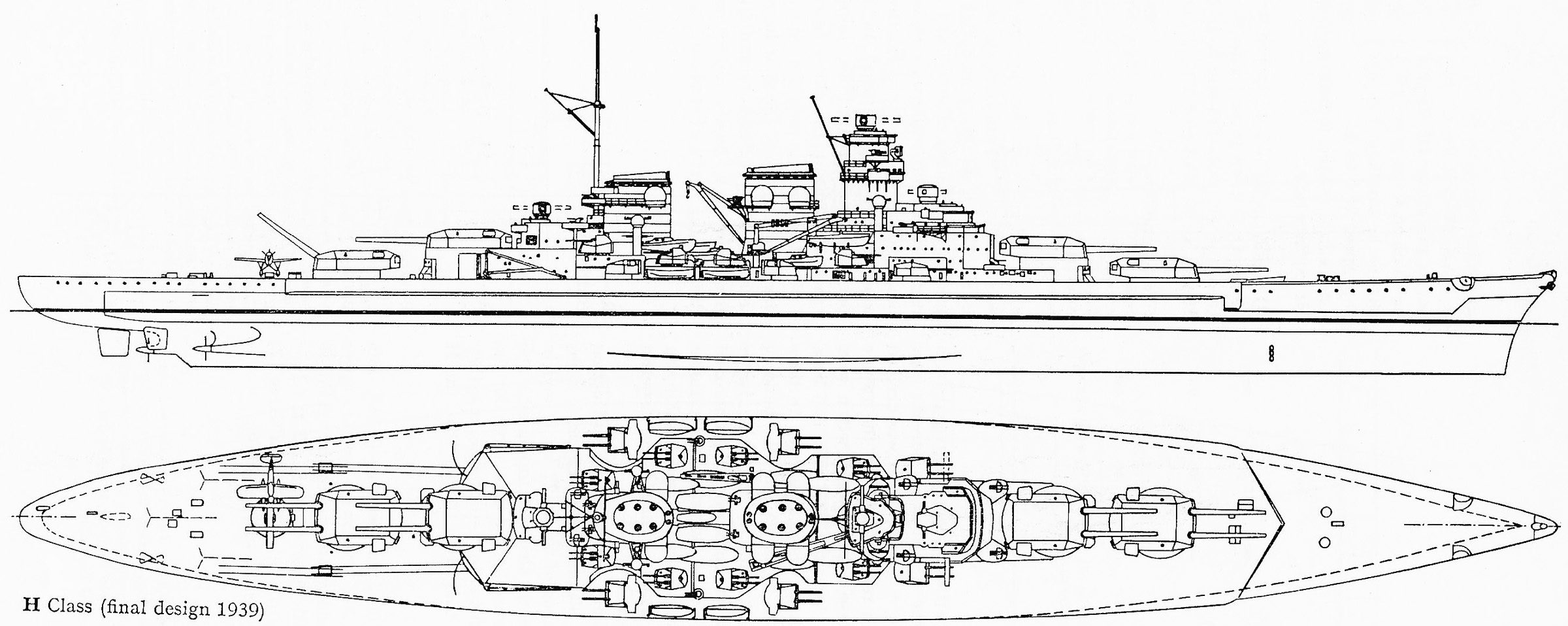
The H class were battleship designs intended for the Kriegsmarine, filling the battleship niche for Plan Z in the 1940s.
-The “H-39”, six enlarged Bismarck-class but with 40.6 cm (16 in) guns and diesels.
-The “H-41” were the same but with larger turrets and 42 cm (16.5 in) main guns plus extra deck armor.
The Construction Office of the Oberkommando der Marine (OKM) did not delivered further plans but variations on the latter, with “H-42” and “H-43” now having instead 48 cm (18.9 in) main guns, and “H-44” going for the properly insane 50.8 cm (20 in) guns. “H-39” were the “midgets” in class at 277.8 m (911 ft 5 in) for 56,444 t (55,553 long tons) standard, but the “H-44” were stretched to 345 m (1,131 ft 11 in) and 131,000 t (129,000 long tons), also standard, so perhaps 180,000 tonnes fully loaded. Most of the designs had a proposed top speed in excess of 30 knots (56 km/h).
When the war started in September 1939, all these pipe dreams were shattered. Only the first two “H-39” were laid down and immediately halted. The assembled steel remained on slipway until November 1941, and then scrapped and recycled, highly valuable for tanks notably. Contracts for the other four “H-39” had been awarded, but no work started when they were canceled. The six H-38 if completed according to plans were probably for mid to late 1944 in the best conditions, the H-42s, if built for 1947-49 and if chosen, the massive H-44 for 1950-55 as planned.
The true completion of Z plan was indeed for 1946 in the short, 1950 in the long run, with six H-38, four H-42 or 43 and two H-44. The latter were considered only for contesting either UK and US naval dominance, on the same prewar thinking as the Yamatos. When planned, Pearl harbour was still far away, and Taranto did not even happened yet. So the true capabilities of aviation against battleships was not yet known.
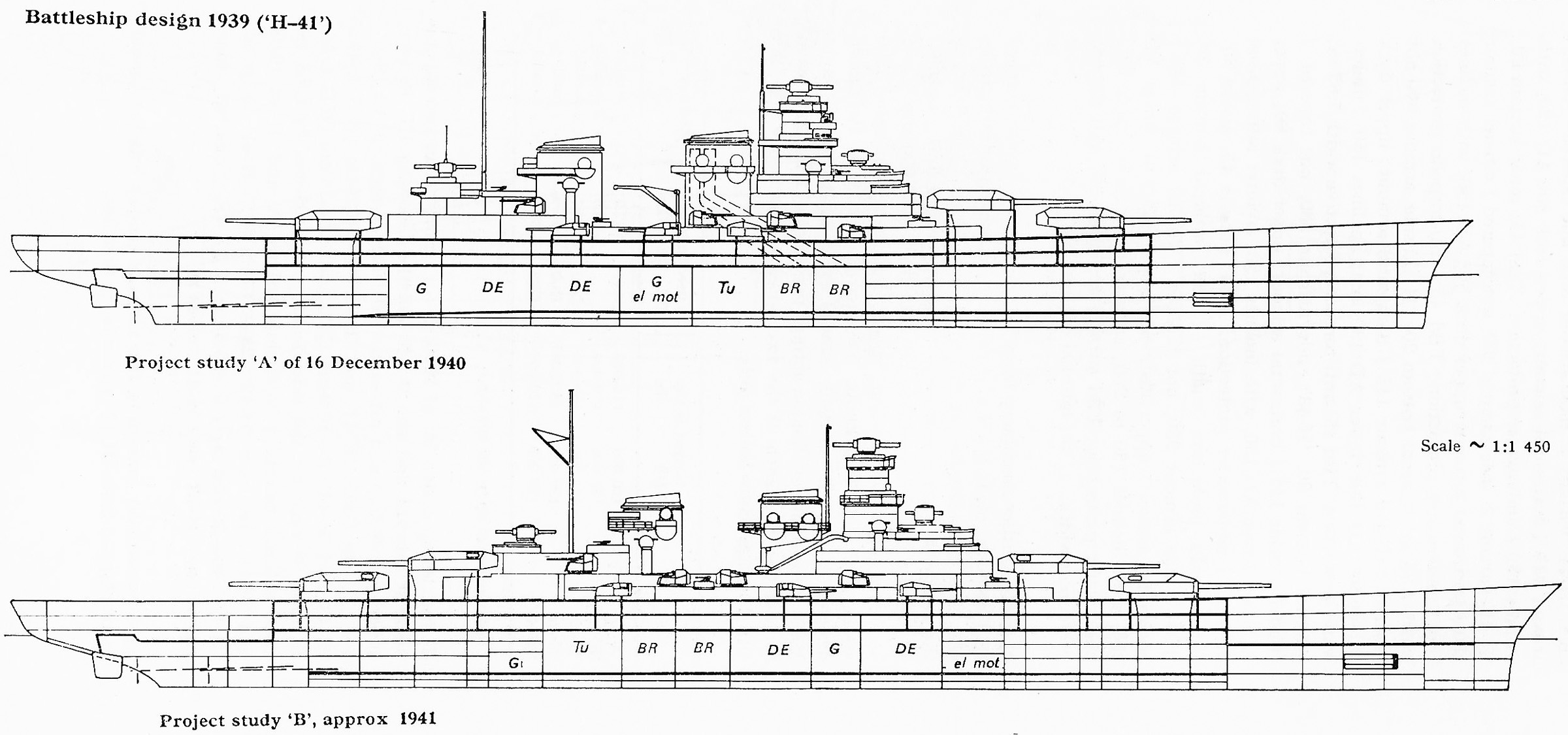
H-40 reconstitution by Breyer, from blueprints
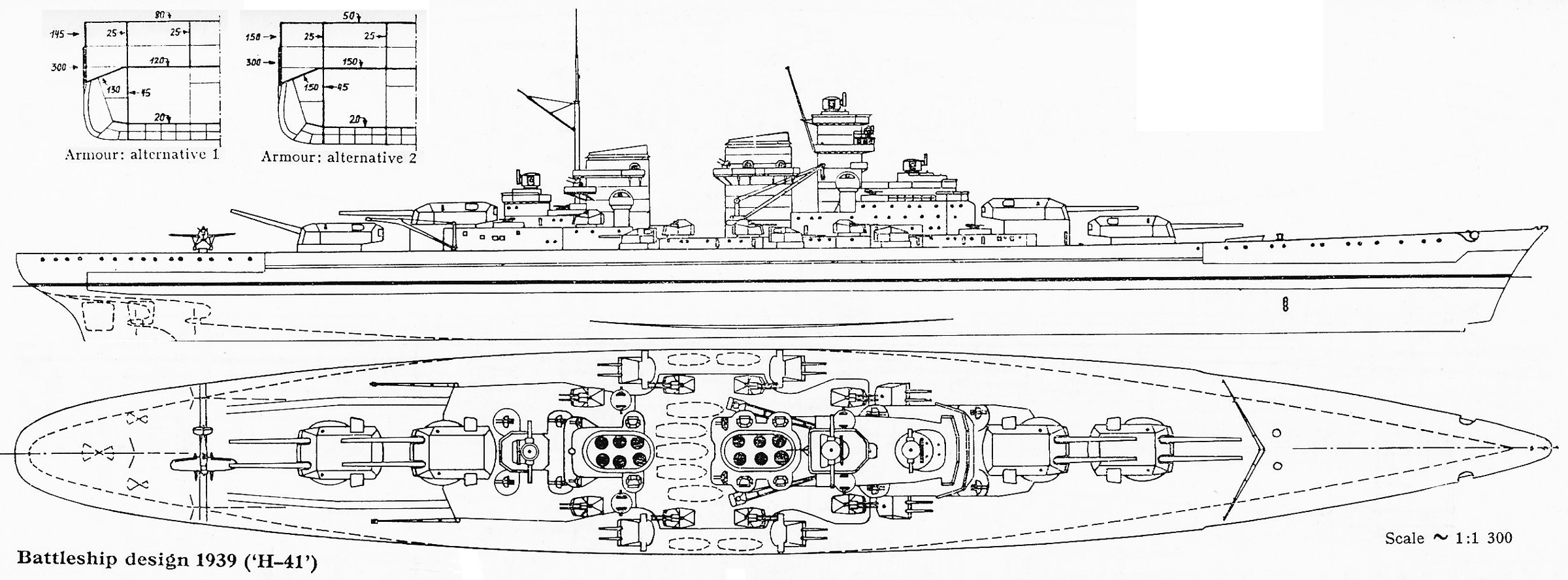
Same, H-41
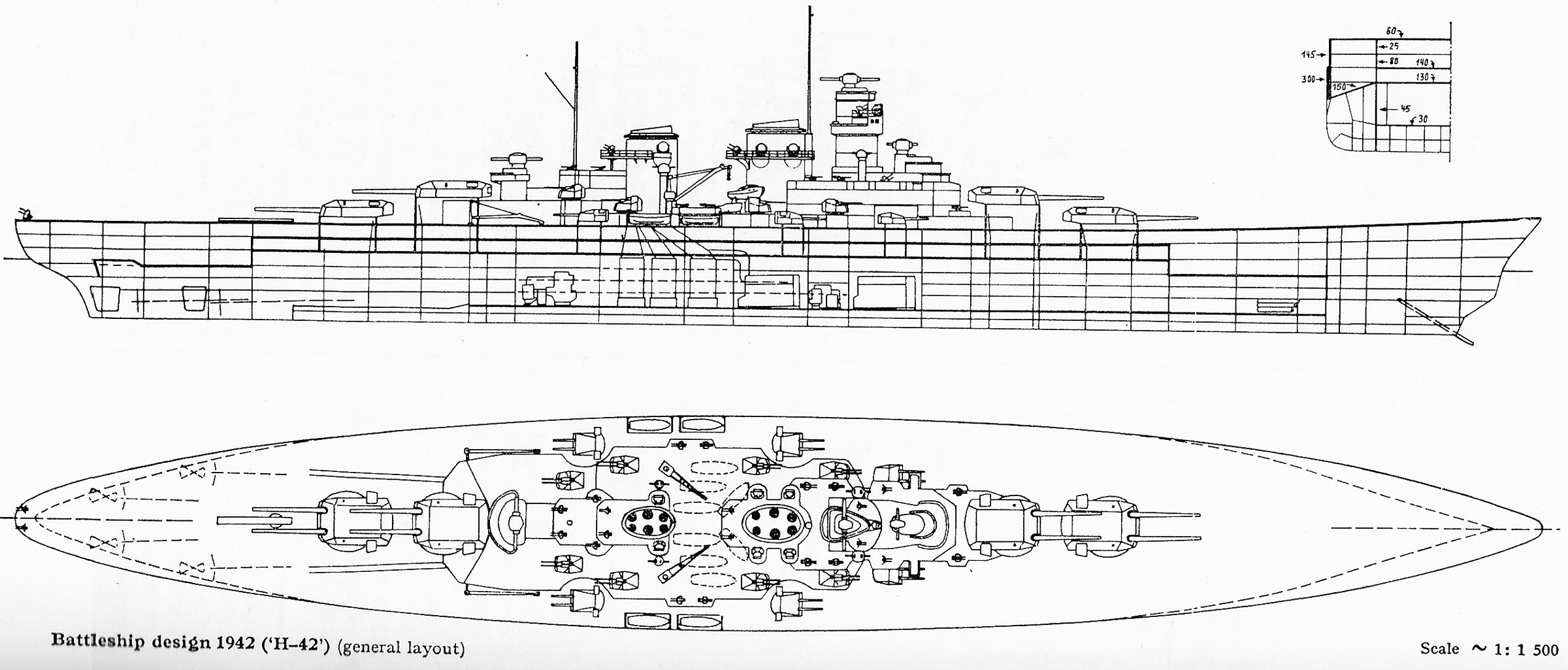
Same, H-42
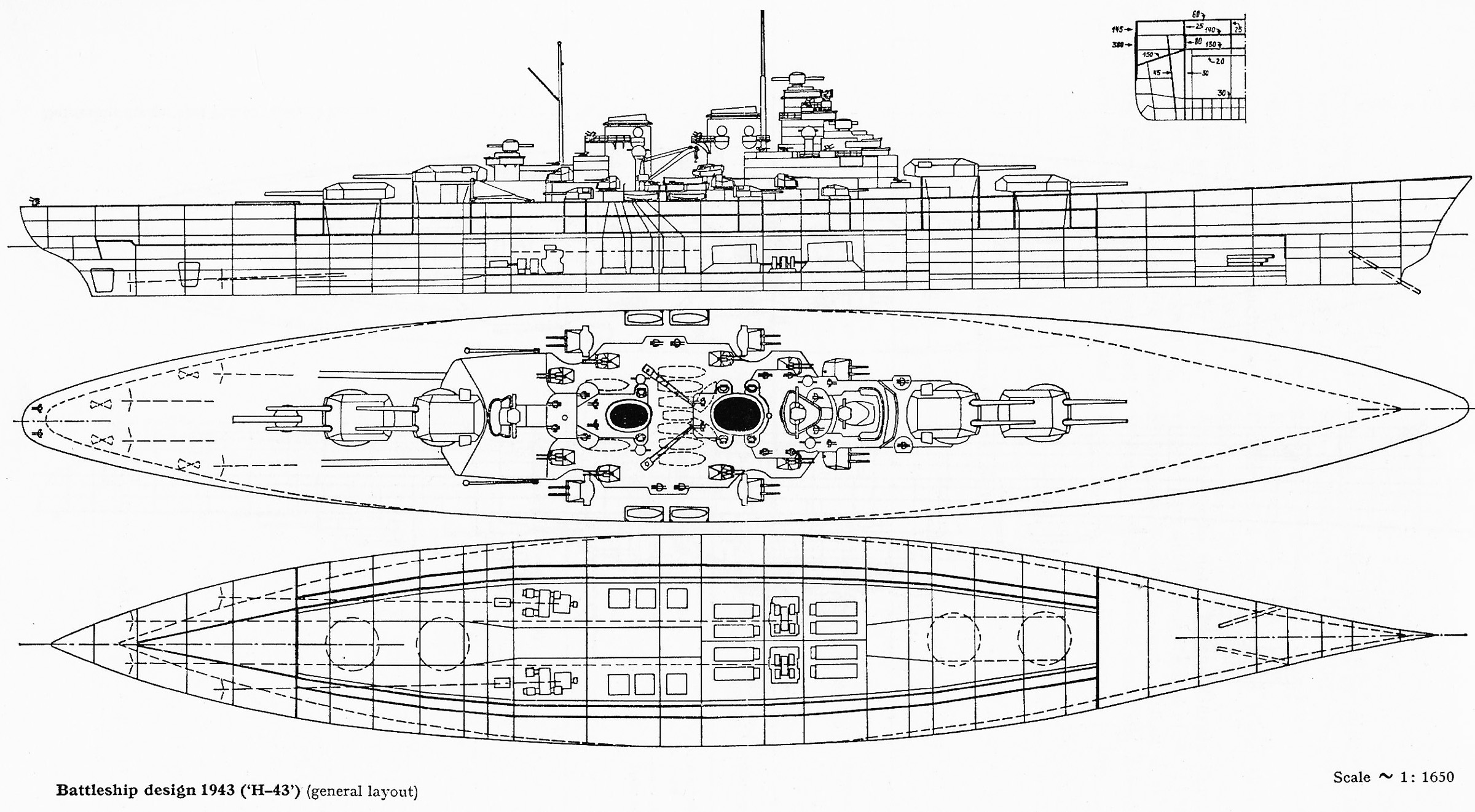
Same, H-43
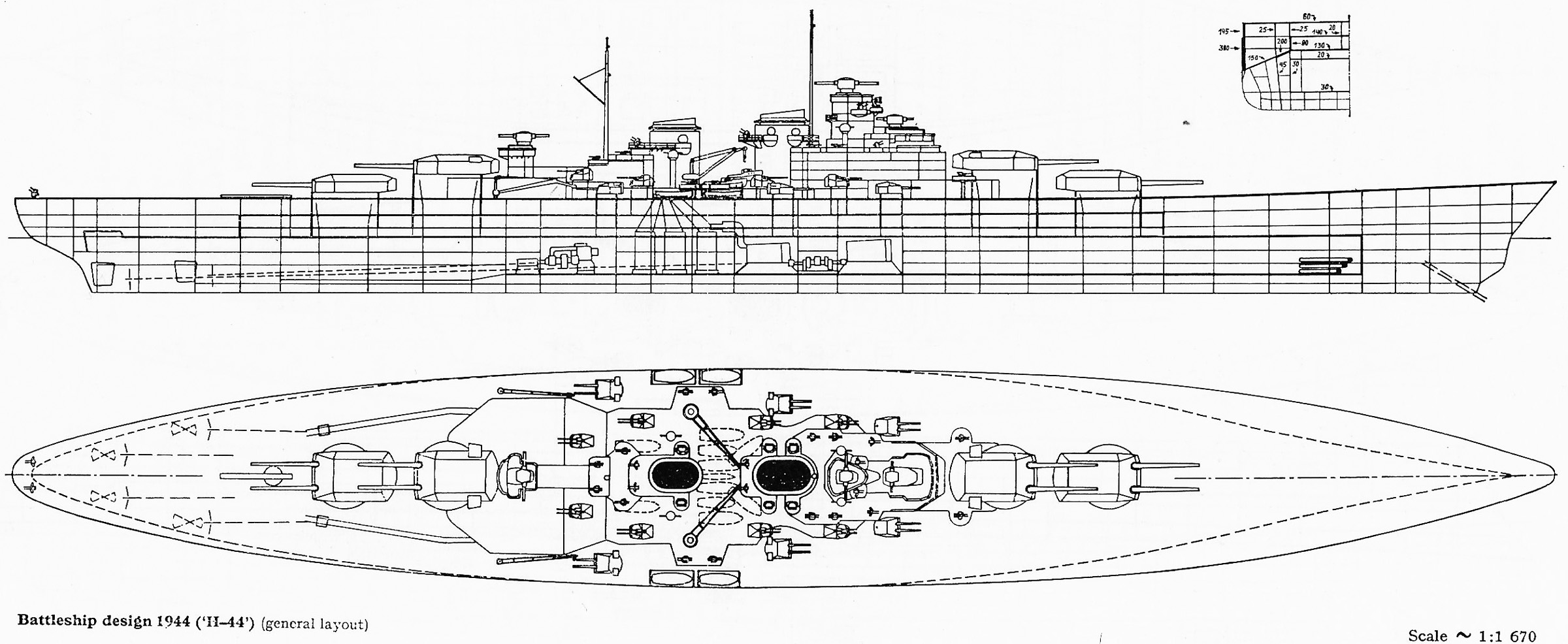
H-44 by Breyer
The most outrageous of all four designs, H-44, was probably the most delirious project to be approved by Hitler. On the Wagnerian scale it was right, but an engineering nightmare and completely unrealistic for German industrial capacities at the time. It was only possible if Hitler’s “lebensraum” was conquered, and all industrial resources of USSR in German hands. As a reminder, no ship above 70,000 tonnes had been planned apart the Yamatos, certainly none above 100,000 tonnes (albeit projects of “maximum battleships” had been regularly thrown around in the interwar) and for that scale, brand new facilities were needed. Such enormous hull posed scores of new issues, notably torsional problems, and even the required 500+ mm armour plates needed (19 inches) would have required also new foundry processes and new facilities. If using diesels and turbines, certainly way more than could be produced at one time would have been required, perhaps even stacked on two levels and exhausted through four funnels.
And that’s only the easy part. Albeit Krupp was confident about producing 503 mm main guns, the main problem remains the turrets in which they would be installed, if provided with independent elevation. This imposed extra width and thus a larger turret ring, in turn imposiding larger barbettes and further pushing its surrounding armour and compartments further. The whole process produced indeed a very long hull and in appearance they would have been probably further inside.
The other issue, more damming, was the blast effect of such ships firing on the whole structure.
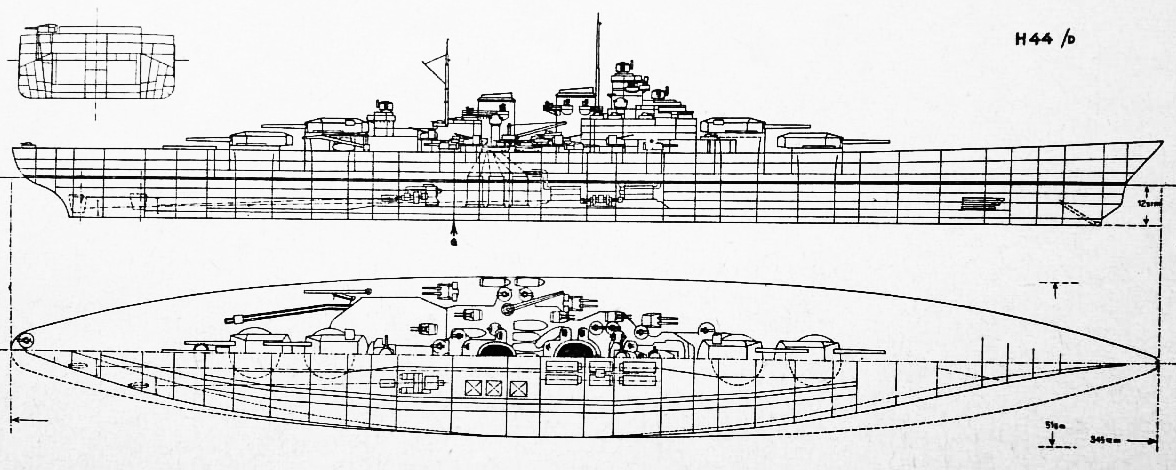
H-44 by Anon
It was believed that a minimal elevation would be mandatory for firing or else, obliterating the wooden weather deck,buckling all plates below, jamming hatches, etc. alternative to a reinforced all-metal shock absorbtion counpound instead. The blast shock would have also destroy many sub-elements, including in the turrets themselves, and the weight of the turrets would have been also a challenge to properly reinforce the hull structure around and below the barbettes. By scaling up the 1056 metric tons of the Bismarck’s turret we speak of something in the order of 3,500 to 4,000 tonnes, taking the Yamato’s 46cm gun turrets as reference (2,774 tonnes). Adding to this the whole armoured barbette, and this is an order of scale above 6,000 tonnes.
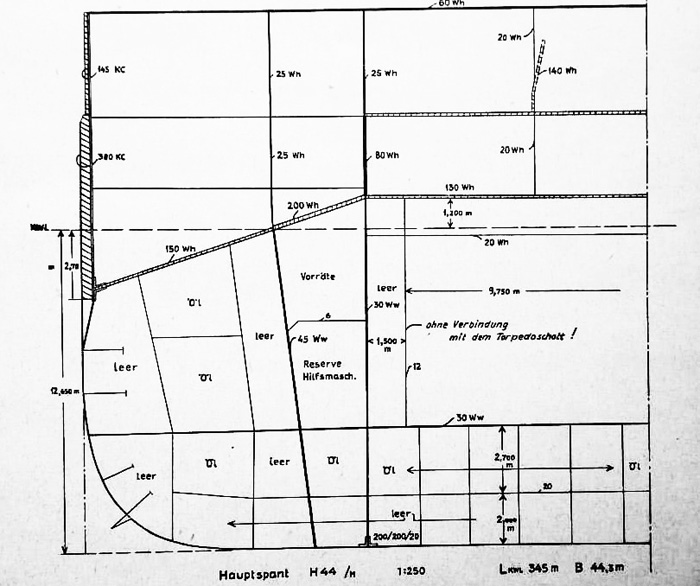
H-44 cross section and armour scheme
In fact, Krupp was aware of future gunnery upscale in 1938 already and started working on an even larger caliber, the 53 cm/52 (21″) Gerät 36. Torpedo diameter… Among the largest guns ever constructed, with the “gustav” and “dora” on land, this were experimental weapons ordered in 1938, and a sibngle barrel and bloc with cradle were manufactured and apparently fired a few times. The final mounting was never completed. They would have been reduced to fit in turrets for the H-44 battleships as the caliber was reduced to 50.8 cm (20″).
The barrels were made of four layers, shrunk liner, A tube, two outer tube layers, and horizontal sliding breech block. As for lifting up and loading at an elevation a 21 inches shell, were can only imagine the issues associated by dealing with such loads.
The guns weight each a staggering 329.8 tons for an overall lenght of 1,090.55 in. (27.700 m) a chamber Volume of 76,280 in3 (1,250 dm3) and at best a one round per minute rate.
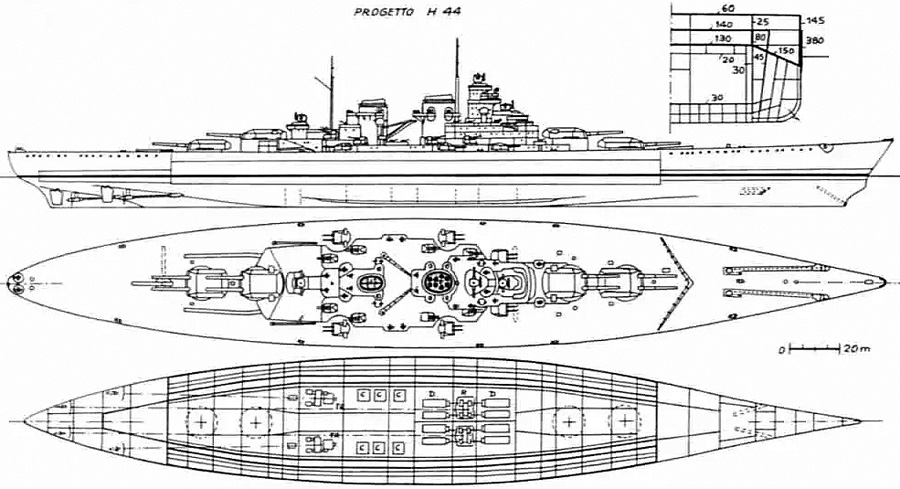
Progetto H-44, italian reconstitution
Actually Krupp designed two shells for it, the APC L/4,9 53.3 cm Psgr. L/4,9 (m.Hb) and HE L/4,9 nose fuze 53.3 cm Spgr. L/4,9 Kz (m.Hb). The APC L/4,9 weighted 4,850 lbs. (2,200 kg) and the HE L/4,9 nose fuze weighted 4,850 lbs. (2,200 kg) for 2,621 or 2,646 meters long, a muzzle velocity of 2,690 fps (820 mps) and range of about 51,950 yards (47,500 m) at 50° elevation, if this even was possible. The H-38, 42-33 main guns howwever were actually serially built as the 40.6 cm/52 (16″) SK C/34 and 42 cm/48 (16.54″) SK C/40. Since their carriers were cancelled, they ended in various fortifications.
Full turrets for the first ones were built, with their barbettes and loading systems.
The Two-gun Turrets “H” (4): Drh LC/34 weighted 1,452 tons (1,475 mt). The single gun land based BSG Coastal Artillery was named Schiessgerät C/39 and way lighter. Eight coastal artillery guns were sent to Norway for Narvik and Tromsø, one gun lost in transit. Three ended in the “Battery Dietl” on the island of Engeløya, the other four at the Battery Trondenes, near Harstad. Krupp also produced for them 1,227 shells. These were your real life “Navarone guns”.
They were serviced by the Norwegian postwar for some time.
Other battleships and Battlecruisers of Z Plan

Rendition of the fictitious “Pommern” – WoW
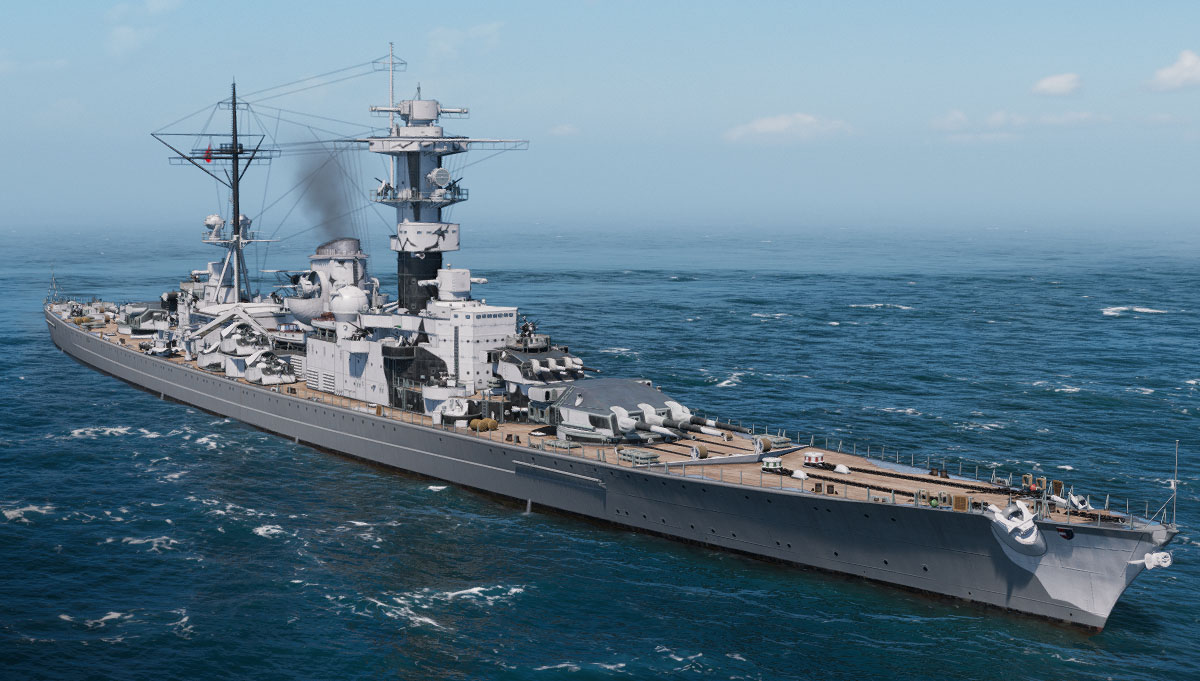
KMS Schill, one of the follow-up commerce raiders imagined by WoW
Read More:
Books
Specs Conway’s all the world fighting ships 1921-1947.
Secret Projects of the Kriegsmarine: Unseen Designs of Nazi Germany’s Navy 2 Mar. 2022 by Nico Sgarlato, Alessio Sgarlato.
Links
http://www.navweaps.com/Weapons/WNGER_Radar.php
http://www.navweaps.com/Weapons/WNGER_21-52_gerat36.php
http://www.navweaps.com/Weapons/WNGER_16-52_skc34.php
https://en.wikipedia.org/wiki/O-class_battlecruiser
https://en.wikipedia.org/wiki/P-class_cruiser
https://en.wikipedia.org/wiki/Plan_Z
https://nationalinterest.org/blog/buzz/h-class-nazi-germanys-insane-141500-ton-monster-battleship-179364
https://en.wikipedia.org/wiki/H-class_battleship_proposals
https://myplace.frontier.com/~wellsbrothers/Battleships/LaterHClass.html
on secretprojects.co.uk/

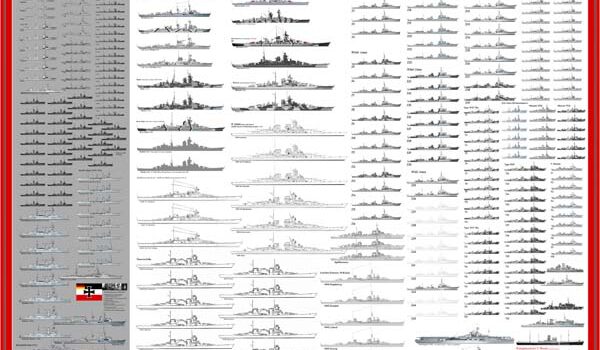

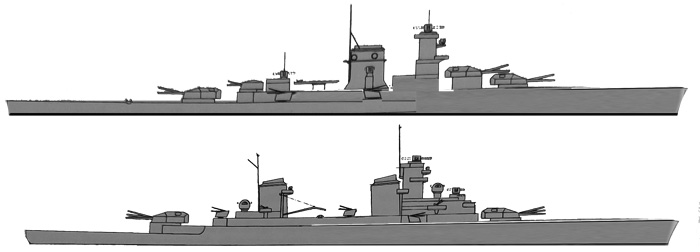
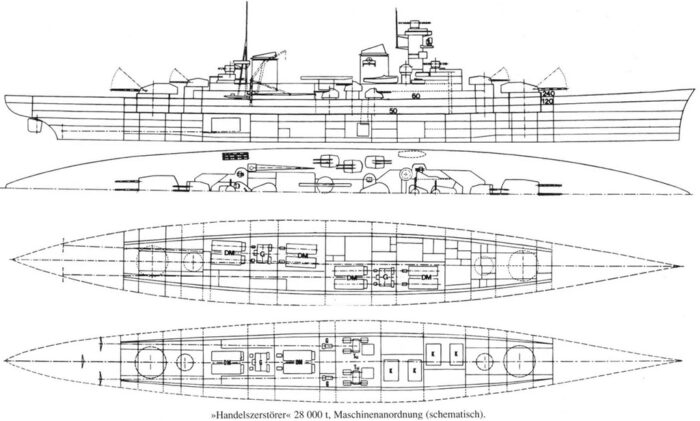
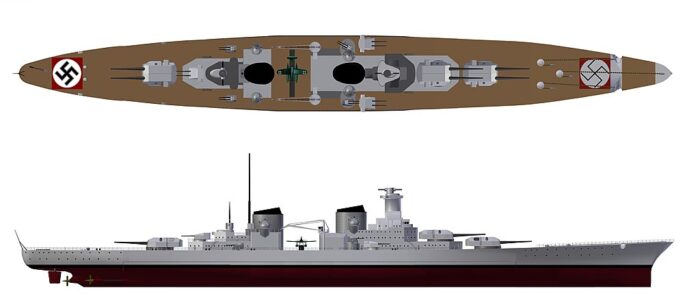


 Latest Facebook Entry -
Latest Facebook Entry -  X(Tweeter) Naval Encyclopedia's deck archive
X(Tweeter) Naval Encyclopedia's deck archive Instagram (@navalencyc)
Instagram (@navalencyc)





 French Navy
French Navy Royal Navy
Royal Navy Russian Navy
Russian Navy Armada Espanola
Armada Espanola Austrian Navy
Austrian Navy K.u.K. Kriegsmarine
K.u.K. Kriegsmarine Dansk Marine
Dansk Marine Nautiko Hellenon
Nautiko Hellenon Koninklije Marine 1870
Koninklije Marine 1870 Marinha do Brasil
Marinha do Brasil Osmanlı Donanması
Osmanlı Donanması Marina Do Peru
Marina Do Peru Marinha do Portugal
Marinha do Portugal Regia Marina 1870
Regia Marina 1870 Nihhon Kaigun 1870
Nihhon Kaigun 1870 Preußische Marine 1870
Preußische Marine 1870 Russkiy Flot 1870
Russkiy Flot 1870 Svenska marinen
Svenska marinen Søværnet
Søværnet Union Navy
Union Navy Confederate Navy
Confederate Navy Armada de Argentina
Armada de Argentina Imperial Chinese Navy
Imperial Chinese Navy Marinha do Portugal
Marinha do Portugal Mexico
Mexico Kaiserliche Marine
Kaiserliche Marine 1898 US Navy
1898 US Navy Sovietskiy Flot
Sovietskiy Flot Royal Canadian Navy
Royal Canadian Navy Royal Australian Navy
Royal Australian Navy RNZN Fleet
RNZN Fleet Chinese Navy 1937
Chinese Navy 1937 Kriegsmarine
Kriegsmarine Chilean Navy
Chilean Navy Danish Navy
Danish Navy Finnish Navy
Finnish Navy Hellenic Navy
Hellenic Navy Polish Navy
Polish Navy Romanian Navy
Romanian Navy Turkish Navy
Turkish Navy Royal Yugoslav Navy
Royal Yugoslav Navy Royal Thai Navy
Royal Thai Navy Minor Navies
Minor Navies Albania
Albania Austria
Austria Belgium
Belgium Columbia
Columbia Costa Rica
Costa Rica Cuba
Cuba Czechoslovakia
Czechoslovakia Dominican Republic
Dominican Republic Haiti
Haiti Hungary
Hungary Honduras
Honduras Estonia
Estonia Iceland
Iceland Eire
Eire Equador
Equador Iran
Iran Iraq
Iraq Latvia
Latvia Liberia
Liberia Lithuania
Lithuania Mandchukuo
Mandchukuo Morocco
Morocco Nicaragua
Nicaragua Persia
Persia San Salvador
San Salvador Sarawak
Sarawak Uruguay
Uruguay Venezuela
Venezuela Zanzibar
Zanzibar Warsaw Pact Navies
Warsaw Pact Navies Bulgaria
Bulgaria Hungary
Hungary

 Bundesmarine
Bundesmarine Dutch Navy
Dutch Navy Hellenic Navy
Hellenic Navy Marina Militare
Marina Militare Yugoslav Navy
Yugoslav Navy Chinese Navy
Chinese Navy Indian Navy
Indian Navy Indonesian Navy
Indonesian Navy JMSDF
JMSDF North Korean Navy
North Korean Navy Pakistani Navy
Pakistani Navy Philippines Navy
Philippines Navy ROKN
ROKN Rep. of Singapore Navy
Rep. of Singapore Navy Taiwanese Navy
Taiwanese Navy IDF Navy
IDF Navy Saudi Navy
Saudi Navy Royal New Zealand Navy
Royal New Zealand Navy Egyptian Navy
Egyptian Navy South African Navy
South African Navy






























 Ukrainian Navy
Ukrainian Navy dbodesign
dbodesign